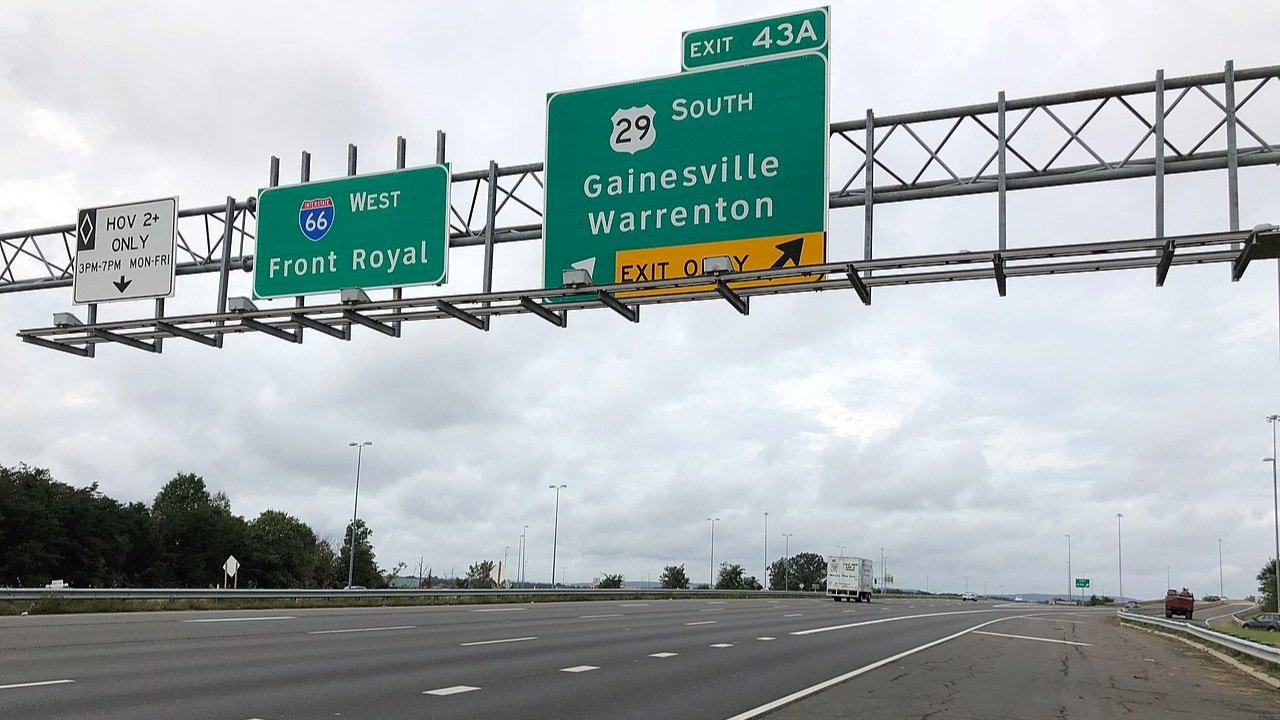Northern Virginia Highway Plans Would Fuel a Massive Increase in Driving
This article was originally published by Greater Greater Washington. It is shared here with permission.
View west along Interstate 66 in Northern Virginia. (Source: Wikimedia Commons.)
The Northern Virginia Transportation Authority (NVTA) will make multibillion-dollar decisions this year on the region’s transportation future—updating both their long-range TransAction plan and their six-year construction plan.
Analysis from the Coalition for Smarter Growth (CSG) finds that the agency’s massive highway expansion plans would fuel increased levels of driving, on top of the additional trips anticipated from population growth. Instead of helping Northern Virginians drive less, the proposed 1,200 miles of new pavement would make the region more car dependent.
CSG’s On the Wrong Road report analyzed the current TransAction plan and found that Loudoun County would expand its arterial highways at a rate of 1.5 times its population growth and Prince William County at a rate of three times faster than its population growth. Fairfax and Manassas would also build arterial highway miles faster than their population growth.
The Impacts of Additional Miles of Driving
The well-documented phenomenon of induced demand shows that new, more expansive highways leads to more cars on the road and more miles of driving. Research also shows that wider highways often fill up with traffic in as little as five years.
CSG used the State Highway Induced Frequency of Travel calculator, developed by Rocky Mountain Institute, and found that the TransAction plans could make Northern Virginia residents and workers drive almost 3 billion more miles per year by 2040 on top of new car trips anticipated from population and job growth.
Vehicle miles traveled (VMT) would increase up to 42% on Loudoun’s highway network, significantly more than the county’s rate of population growth, and up to 60% on Prince William’s non-interstate highways, almost three times the rate of its population growth. Fairfax would also see a massive long-term increase in driving due to its roadway expansion.
Induced driving from TransAction 2040 interstate and principal arterial expansion projects. (Source: Coalition for Smarter Growth.)
Decades of real-life examples and national studies show that widening major roads leads to people making more and longer auto trips, or making those trips during busy times of the day or on busier roads they would normally avoid. This adds traffic back to those expanded highways within five to ten years. New and expanded highway projects also spark more spread-out and auto-dependent development, which generate even more driving and traffic over time.
This increased car dependence would also make it impossible for Northern Virginia to meet its climate commitments. We know from multiple studies at the local and national levels that electric vehicles and a cleaner electrical grid will not be enough; we also have to reduce the number of miles people have to drive. Moreover, more than 80% of people in the region want their elected officials to consider climate change in transportation planning, according to a 2021 Voices of the Region survey.
While NVTA has funded many great transit, rail, pedestrian, and bicycle projects, they tend to be concentrated in Arlington, Alexandria, Falls Church, and inner parts of Fairfax. Overall, NVTA has dedicated most of its billions in regional funding to expanding highways and thoroughfares, and its proposed six-year funding program would do the same, allocating almost two-thirds of its funds to highway and other major roadway expansion.
NVTA TransAction 2040 projects. (Source: Coalition for Smarter Growth.)
A More Sustainable and Livable Vision for Northern Virginia
The good news is that NVTA and the elected officials that comprise its board have the opportunity this year to change their six-year and other long-term plans to prioritize investment in walkable, transit-oriented communities.
CSG is calling on NVTA to:
Develop and test alternative combinations of projects and land use for TransAction rather than simply studying one large wish list of projects.
Show the effects of induced demand for road expansion projects in their plans.
Establish sustainability and travel mode share targets informed by TPB’s climate change study.
Elevate more meaningful performance metrics for the region’s residents and workers such as travel times, equitable job access, VMT, safety, and climate pollution, and put less focus on car congestion.
Provide more transparency by requiring that member jurisdictions and agencies hold advertised public hearings on their proposed submissions for NVTA funding, the TransAction plan, and other regional plans like the Transportation Planning Board’s Visualize 2045.
Adopt a plan that will foster more walkable, transit-oriented communities with a range of housing options.
These considerations could enable Northern Virginians to drive less, have more options to get around or live closer to destinations, spend less money on transportation, travel more safely, avoid the worst effects of climate change, and protect our farms, forests, and natural resources.
Bill Pugh, AICP CTP, is a senior policy fellow at the Coalition for Smarter Growth, which advocates for walkable, bikeable, inclusive, and transit-oriented communities in the Washington, DC, region.







Designing streets to encourage safe behavior is a powerful tool for creating lasting prosperity. But when cars are designed to encourage unsafe behavior, it threatens to undo that progress.